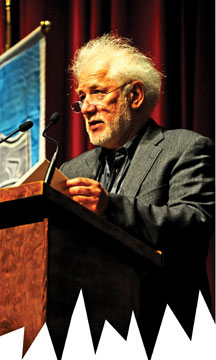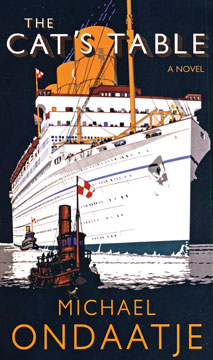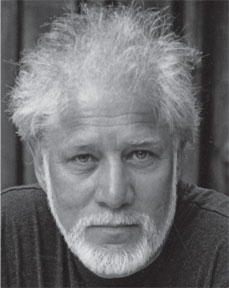|
A voyage of discovery :
Exploring the nexus between childhood and adulthood
By Ranga CHANDRARATHNE
 Although
The Cat’s Table offers readers with rich textured prose and almost
photographic memoirs directly connected with the lives and evolution of
characters of its passengers, the line between the fiction and faction
is rather blurred. It seems that the author has exploited the literary
licence to the maximum in ‘colouring’ the texture with incidents from
the past as well as grotesque descriptions of the locations and times
such as St.Thomas’ in Mount Lavinia. According to the author, the
incidents and descriptions of the locations are purely fictional and do
not, therefore, reflect the milieu against which the story is set. Although
The Cat’s Table offers readers with rich textured prose and almost
photographic memoirs directly connected with the lives and evolution of
characters of its passengers, the line between the fiction and faction
is rather blurred. It seems that the author has exploited the literary
licence to the maximum in ‘colouring’ the texture with incidents from
the past as well as grotesque descriptions of the locations and times
such as St.Thomas’ in Mount Lavinia. According to the author, the
incidents and descriptions of the locations are purely fictional and do
not, therefore, reflect the milieu against which the story is set.
The Cat’s Table, the latest novel by Michael Ondaatje, recounts,
principally, the passage of an 11-year-old boy named Michael from
childhood to adulthood in the space of three-week’s journey from Colombo
to England via the Suez Canal in the cruise liner Oronsay.
Interestingly, the name and the time of the narrator Michael slightly
coincide with the author’s journey from Colombo to England. The Cat’s
table is the lowest rank of dining arrangements for contradictory and
dissimilar boys who seek school admission in England; “Mynah”, (the
narrator Michael), tough boy Cassius and weak and philosophical Ramadhin,
provide the readers with an important vantage point. From that vantage
point, the narrator could survey the entire liner across the class
distinctions and diverse dramatic personae, who people it during its
voyage.
The novel commences with the narrator, a -11-year-old boy named
Michael boarding the ship berthed at Colombo harbour for the first and
the last time in his life,: “ He was eleven years old that night when,
green as he could be about the world, he climbed aboard the first and
only ship of his life.
He went up to the gangplank, watching only the path of his
feet-nothing ahead of him existed –and continued till he faced the dark
harbour and sea. There were outlines of other ships futher out,
beginning to turn on lights.
He stood alone, smelling everything, and then came back through the
noise and the crow to the side that faced land. A yellow glow over the
city. Already it felt there was a wall between him and what took place
there. …”
 It
is the entry of the narrator into an entirely new world, a sailing
castle on the vast sea which can easily be compared to the world with
its diverse social strata. However, from the very commencement of the
novel, it is clear that the very purpose of the novelist is not to do a
class analysis as in the Titanic although Oronsay is a luxury cruise
ship. The purported intent of the author seems to portray the evolution
of the narrator’s character. The maturity of the 11-year-old trio
achieve through the interaction with the adult’s world and some daring
acts they willingly engage during the course of the journey. From
initial encounter with the adults, the trio seems to be infected with
the curiosity around the strange goings –on in the liner. It
is the entry of the narrator into an entirely new world, a sailing
castle on the vast sea which can easily be compared to the world with
its diverse social strata. However, from the very commencement of the
novel, it is clear that the very purpose of the novelist is not to do a
class analysis as in the Titanic although Oronsay is a luxury cruise
ship. The purported intent of the author seems to portray the evolution
of the narrator’s character. The maturity of the 11-year-old trio
achieve through the interaction with the adult’s world and some daring
acts they willingly engage during the course of the journey. From
initial encounter with the adults, the trio seems to be infected with
the curiosity around the strange goings –on in the liner.
Assortments of characters
The ship is peopled by an assortments of characters "Emily, Mynah’s
cousin (Michael) on whom Michael depends at times of distress, Flavia
Prins, a first –class traveller whose husband know’s Michael’s uncle and
who has promised to keep an eye on him. Later she proves to be a gossip
monger.
The diverse characters have their own hobbies; Miss Lasqueti keeps a
cage of pigeon. Asuntha is isolated and in a green dress concealing a
terrible secret. Sri Lankan millionaire Sir Hector de Silva is in a
luxurious suit dying from a curse. The teacher Mr.Fonseka is armed with
books and burns a bit of hemp rope to recall the past, Mr.Danial has a
huge garden of medicinal as well as poisonous herbs and Max Mazappa or
Sunny Meadows is a jazz musician who befriends with Miss Lasqueti but
leaves the ship at Port Said. However, the most intriguing character is
the lonely prisoner who walks in the midnight on the deck under heavy
guard.
The primary purpose of the assortments of diverse characters is to
provide the readers with a rich texture with many treads and patterns.
At a different level, they serve the author to go back and forth in time
on the one hand to recall his memories of Ceylon and to bring out
diverse aspects of life on the other.
Prisoner
|

Michael Ondaatje |
The very appearance of the prisoner is intriguing and the prisoner,
among other elements such as Sir Hector de Silva’s curse, provides the
novel with an aura of mystery.
“It was before midnight. The deck shone because of a cloudless moon.
He appeared with the guards, one chained to him, one walking behind him
with a baton. We did not know what his crime was. We assumed it could
only have been a murder. The concept of anything more intricate, such as
crime of passion or a political betrayal, did not exist in us then. He
looked powerful, self-contained, and he was barefoot”
Nostalgia
The major thread of the novel is nostalgia. It is not only the
recollections and snap shots of personal history of the narrator but
also of different characters and the time they live in. On one instance,
the narrator reveals in a kind of soliloquy, his personal history and
how his parent’s divorce and about his formative years in Ceylon:
“When my parents abandoned their marriage, it was never really
admitted or explained but it was not hidden. If anything, it was present
as a mis-step, nor a car crash. So how much the curse of my parent’s
divorce fell upon me I am not sure. I do not recall the weight of it.
The boy goes out the door in the morning and will continue to be busy in
the evolving map of his world. But it was a precarious youth…what was I
in those days? I recall no outside imprint, therefore, no perception of
myself. If I had to invent one photograph of myself from childhood, it
would be of a barefoot boy in shorts and a cotton shirt, with a couple
of friends from the village, running along the mildewed wall that
separated the house and garden in Boralesgamuwa from the traffic on the
High Level Road…”
One of the potent objects of nostalgia is ‘a hemp rope’. The readers,
first, find the ‘hemp rope’ in the narrator’s recollection of his
childhood in Boralesgamuwa and later ‘ burning hemp rope’ has been aptly
used to bring about loads of recollections about the bygone life in
Ceylon when the narrator goes in search of the smell coming from a cabin
in Oronsay only to find Mr. Fonseka, the teacher.
“I always joined Narayan for this dawn meal after he awakened the
generator. Breakfast with him on High Level Road was not to be missed,
even though it meant I would have to consume another, more official
breakfast with the family an hour or two later. But it was almost heroic
to walk with Narayan in the dissolving dark, greeting the waking
merchants, watching him bend to light his beedi on a piece of hemp rope
by the cigarette stall…And then, one day, I smelled burning hemp on the
ship. For a moment I stood still, then moved towards a staircase where
it was stronger, hesitated about whether to go down or up, then climbed
the stairs. The smell was coming from a corridor on D level. I stopped
where it seemed strongest, got on my knees, and sniffed at the inch of
crack under the metal door…”
Emily
It is this burning of hemp that the narrator leads to discover Mr.
Fonseka, the teacher. The narrator meeting with Emily years after the
journey and now Emily leads a secluded life in a cottage in Canada.
“And so I continued to watch Emily, this person who had been for a
while some kind of despot of beauty in my youth. Though I knew her also
as quiet and cautious, even if she sometimes gave off the air of an
adventurer. But the stories of her married life, in their various
postings, and the affairs of the heart that had occurred, seemed a
familiar version of my cousin, as she had been on the Oronsay. Had she
become the adult she was because of what had happened on that journey? I
didn’t know. I would never know how much it had altered her. I simply
thought it over to myself at that moment in Emily’s spare cottage on one
of the Gulf Islands, where she appeared to be living alone, seeming to
hide herself away…Then, when her marriage finally ended, Emily decided
for some sad reason on a sort of exile on this quiet island on the West
coast of Canada…
It seemed a not quite real life compared with what she and I probably
imagined when we were young. I still had memories of us on bicycles
being slammed by a monsoon rain, or Emily sitting cross-legged on a bed
as she talked about that school in India, and her lean brown arms waving
to me during one of our dances. I thought of those moments as I walked
beside her now.”
Here nostalgia works not only as a conduit between the past childhood
memories and the present but also as filling the gaps in a long
narrative that took place in the post journey era. These snap shots of
nostalgia and soliloquies of the narrator lend authenticity in an
organic manner to the narrative and would make the journey
metaphorically longer than it had actually happened. At deeper level, it
makes much needed connectivity of the journey with the life journey of
Oronsay’s passengers.
The novel ends with a memorable passage describing the narrator
Michael meeting up with his mother in England.
“ … A few hours earlier I had unrolled and put on my first pair of
long trousers. I had put on socks that crowded my shoes. So I was
walking awkwardly as we all descended the wide ramp down to the quay. I
was trying to find who my mother was. There no longer remained any sure
memory of what she looked like. I had one photograph, but that was at
the bottom of my small suitcase…It must have been a hopeful or terrible
moment, full of possibilities.
How would he behave towards her? A courteous but private boy, or some
eager for affection. I see myself best, I suppose, through her eyes and
through her needs as she searched the crowd, as I did, for something
neither of us knew we were looking for, as if the other were as
accidental as a number plucked from a pail who would then be an intimate
partner for the next decade, even for the rest of our lives…”
Journey
The novel narrates a journey from childhood to adulthood as well as a
passage from homeland to another country. The sense of passing the
demarcation between the East and the West was strongly evoked when the
ship passes through the Suez Canal. They hang on the bow rail, "where we
could witness the fragmentary tableaux below us – a merchant with his
stall of food, engineers talking by a bonfire, the unloading of refuse,
all of them, all of this, we knew we would never see again. So we came
to understand that small and important thing, that our lives could be
large with interesting strangers who would pass us without any personal
involvement."
The memoirs of all what had taken place on board the Oronsay were
carried on in the memories of its passengers, how they shaped their
lives as never before.
Wafer thin line between fiction and faction
Although The Cat’s Table offers readers with rich textured prose and
almost photographic memoirs which directly connected with the lives and
evolution of characters of its passengers, the line between the fiction
and faction is rather blurred. As if to cast off any doubt about its
fiction, at the end of the novel the author states in no uncertain terms
that “Although the novel sometimes uses the colouring and locations of
memoir and autobiography, The Cat’s Table is fictional-from the captain
and crew and all its passengers on the boat down to the narrator…”
What is intriguing and ambiguous is the term ‘colouring’ and it is
not quite clear whether the locations such as Boralesgamuwa and High
Level Road are too purely fictional as well as the legend of Sir Hector
de Silva which may or may not have any association with a similar yarn.
Sir Hector de Silva’s legend is described as: “It had happened this way.
One morning Hector de Silva had been breakfasting on his balcony with
friends... At that moment, a venerable battaramulle- or holy
priest-walked past the house. Seeing the monk, Sir Hector punned off the
title by saying ‘Ah, there goes a muttaraballa’. Muttara means
‘urinating’, and balla means ‘dog’. Therefore, ‘There goes a urinating
dog’.
Remark
It was a quick-witted but inappropriate remark. Having overheard the
insult, the monk paused, pointed to Sir Hector, and said, ‘I’ll send you
a muttaraballa…’ ” . Cassius’s descriptions about St.Thomas’ in Mount
Lavinia are such an account which is highly doubtful and unconvincing.
The description is about the inferior quality toilets at the school.
“… He was especially celebrated after he managed to lock ‘Bamboo Stick’
Barnabus, our boarding-house master, in the junior school toilet for
several hours to protest the revolting lavatories at the school. (You
squatted over a hole of hell and washed yourself afterwards with water
from a rusty tin that once held Tate & Lyle golden syrup. ‘Out of the
strong came forth sweetness’, I would always remember.). ”
Although the description of locking up the boarding master may help
highlight the adventurous Cassius’s character, one would doubt whether
it is absolutely necessary to go into such gory details of toilet
facilities at the school.
It is doubtful whether the author is subscribing to the notion ‘East
is dirty and the West is exotic’. Throughout the novel in such grotesque
descriptions line between the fiction and faction is blurred and the
author can, always, argue that such descriptions have also been used for
‘colouring’ the narrative. After all, it is the literary licence of the
author. |

